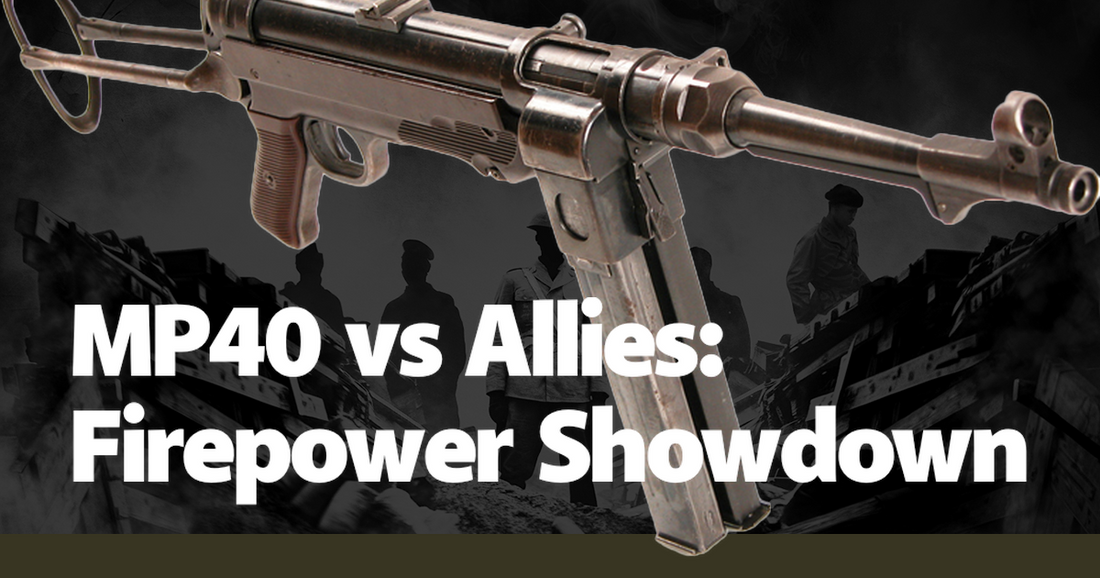The MP40 submachine gun, a staple of German infantry during World War II, often finds itself at the center of discussions comparing Axis and Allied weaponry. Known for its compact design, ease of use, and reliability, the MP40 was a formidable tool in the hands of German soldiers. Its 9mm Parabellum rounds, delivered via a 32-round magazine, allowed for both rapid-fire and controlled bursts. The weapon's folding stock and manageable recoil made it particularly effective in urban combat and close-quarter battles, where maneuverability and quick target acquisition were paramount. Stories from the Eastern Front often recount German soldiers wielding MP40s to devastating effect, their bursts of fire echoing through the ruins of Stalingrad.
In contrast, the Allies fielded a variety of submachine guns, each with its own strengths and weaknesses. The American M1 Thompson, or "Tommy Gun," was renowned for its stopping power and rugged design. Chambered in .45 ACP, the Thompson delivered a heavier punch than the MP40, making it highly effective in close combat scenarios. However, its heavier weight and more complex manufacturing process made it less practical for mass production and distribution. British forces, on the other hand, relied on the Sten gun, a simpler and cheaper alternative that could be produced quickly and in large numbers. While the Sten's reliability was sometimes questioned, its ease of use and the ability to be produced in makeshift workshops made it a valuable asset during the war.
In the thick of combat, the differences between these weapons could mean the difference between life and death. Anecdotes from the Battle of the Bulge highlight the MP40's advantage in rapid deployment and ease of handling. German paratroopers, dropped behind enemy lines, were able to quickly bring their MP40s to bear against unsuspecting Allied troops, their compact size allowing for swift movement through dense forests and snow-covered terrain. Conversely, American soldiers often found the heavier Thompson cumbersome in such conditions, its weight becoming a hindrance in prolonged engagements.
One notable example of the MP40's effectiveness comes from the battle for Monte Cassino. German paratroopers, entrenched in the monastery and surrounding hills, used their MP40s to deadly effect against advancing Allied forces. The weapon's ability to deliver sustained fire in close quarters allowed the Germans to hold their positions against numerically superior forces. Allied troops, armed with a mix of Thompsons and Stens, struggled to match the MP40's rate of fire and ease of handling in the rugged terrain. The battle, which dragged on for months, became a testament to the MP40's design and the tactical advantage it provided in defensive operations.
However, the Allies were not without their own success stories. The Thompson's stopping power proved invaluable during the D-Day landings, where American paratroopers and infantrymen used it to clear bunkers and trenches with brutal efficiency. The weapon's .45 ACP rounds were capable of penetrating the thick clothing and makeshift armor worn by German soldiers, ensuring that a single burst could incapacitate an enemy combatant. In the close confines of the Normandy bocage, the Thompson's firepower often gave American troops the edge in brutal, close-quarters skirmishes.
The Sten gun, despite its shortcomings, also played a crucial role in the Allied war effort. Its simplicity and ease of production made it a favorite among resistance fighters and partisans across occupied Europe. Stories from the French Resistance often describe Sten guns being used in daring ambushes and sabotage missions, their lightweight design allowing for quick getaways and easy concealment. The weapon's ability to be produced in secret workshops meant that even in the most dire circumstances, resistance fighters could arm themselves against their occupiers.
Ultimately, the MP40 and its Allied counterparts each had their own unique advantages and limitations. The MP40's design made it a versatile and reliable weapon in the hands of German soldiers, particularly in urban and close-quarter combat. The Thompson's stopping power and rugged construction made it a formidable tool for American forces, particularly in the brutal fighting of the Western Front. The Sten gun's simplicity and ease of production made it a valuable asset for both regular troops and resistance fighters alike. Each weapon, in its own way, contributed to the complex and multifaceted nature of World War II combat.
In the grand scheme of the war, the differences between these weapons reflect the broader strategic and logistical challenges faced by both the Axis and Allied powers. The MP40's design and production were emblematic of Germany's focus on high-quality, precision-engineered weaponry, while the Thompson and Sten guns reflected the Allies' emphasis on mass production and adaptability. These differences, while seemingly minor on the surface, played a significant role in shaping the tactics and outcomes of countless battles throughout the conflict. The firepower showdown between the MP40 and its Allied counterparts serves as a microcosm of the broader struggle between two vastly different military philosophies.

